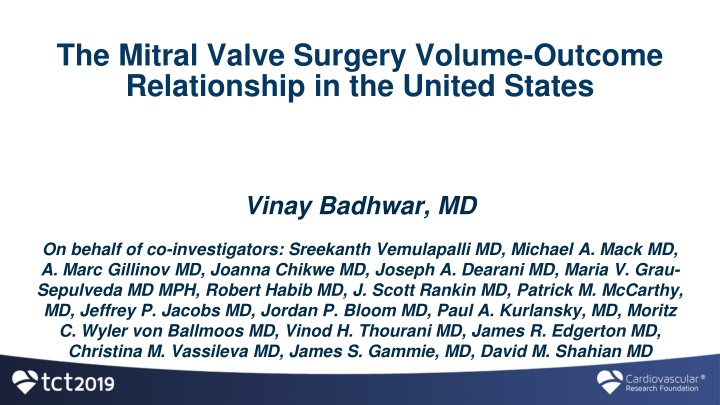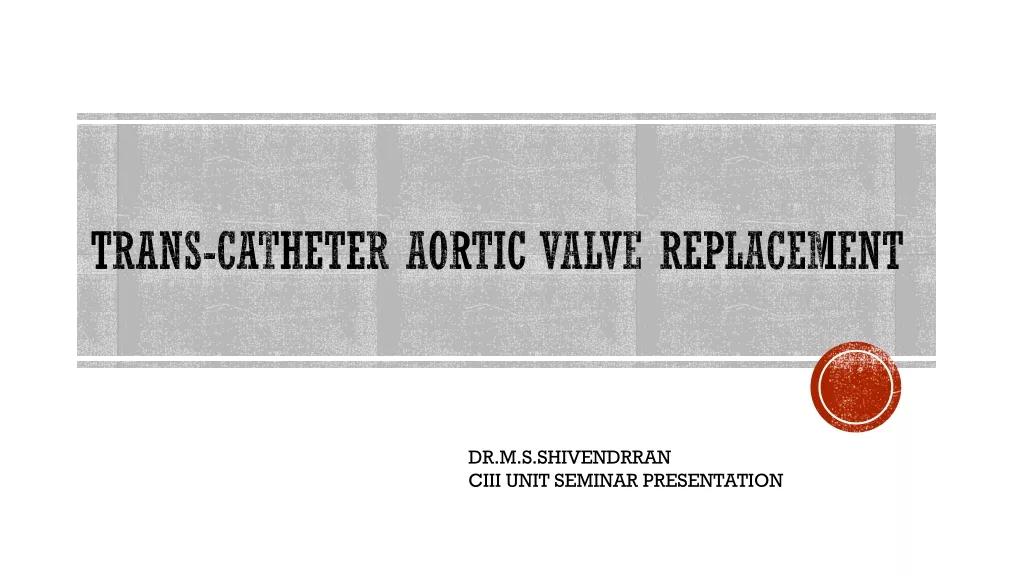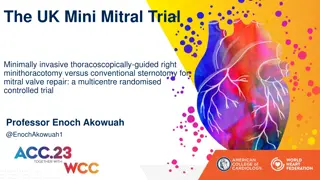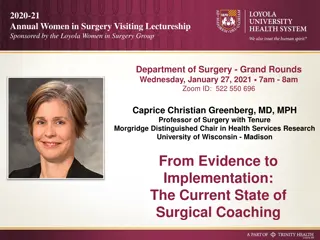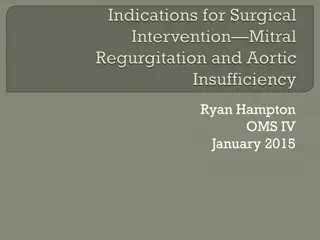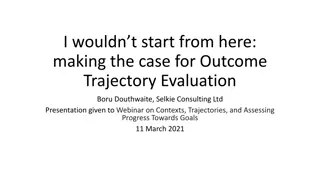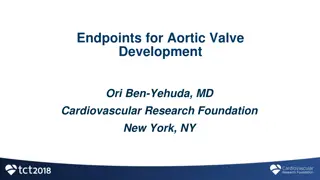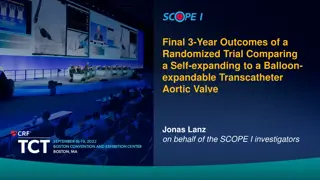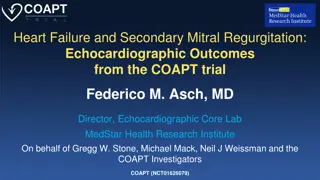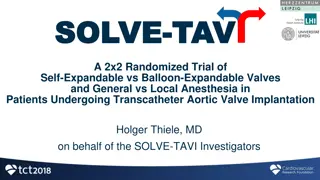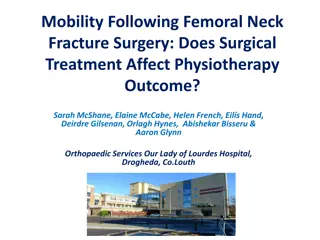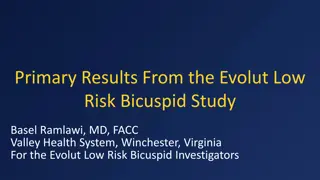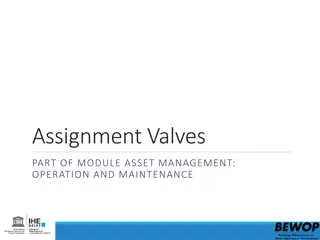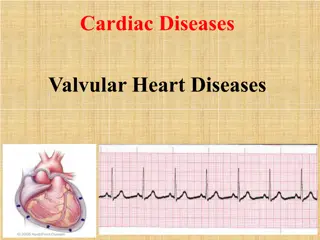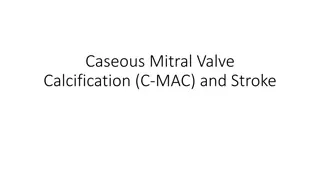Mitral Valve Surgery Volume-Outcome Relationship in the US
This study examines the relationship between surgical volume and outcomes in mitral valve surgery in the United States. It assesses outcomes following MV repair or replacement, defines volume-outcome relationships at hospital and surgeon levels, and utilizes national clinical data from the Society of Thoracic Surgeons. The methods, objectives, and data sources are outlined in detail.
Download Presentation

Please find below an Image/Link to download the presentation.
The content on the website is provided AS IS for your information and personal use only. It may not be sold, licensed, or shared on other websites without obtaining consent from the author.If you encounter any issues during the download, it is possible that the publisher has removed the file from their server.
You are allowed to download the files provided on this website for personal or commercial use, subject to the condition that they are used lawfully. All files are the property of their respective owners.
The content on the website is provided AS IS for your information and personal use only. It may not be sold, licensed, or shared on other websites without obtaining consent from the author.
E N D
Presentation Transcript
The Mitral Valve Surgery Volume-Outcome Relationship in the United States Vinay Badhwar, MD On behalf of co-investigators: Sreekanth Vemulapalli MD, Michael A. Mack MD, A. Marc Gillinov MD, Joanna Chikwe MD, Joseph A. Dearani MD, Maria V. Grau- Sepulveda MD MPH, Robert Habib MD, J. Scott Rankin MD, Patrick M. McCarthy, MD, Jeffrey P. Jacobs MD, Jordan P. Bloom MD, Paul A. Kurlansky, MD, Moritz C. Wyler von Ballmoos MD, Vinod H. Thourani MD, James R. Edgerton MD, Christina M. Vassileva MD, James S. Gammie, MD, David M. Shahian MD
Disclosure Statement of Financial Interest I, Vinay Badhwar DO NOT have a financial interest/arrangement or affiliation with one or more organizations that could be perceived as a real or apparent conflict of interest in the context of the subject of this presentation.
Management of Primary Mitral Regurgitation Early surgical correction of severe primary degenerative MR is recommended provided optimal outcomes are achievable. Durable mitral valve repair is superior to replacement for primary MR The association of volume to outcome for mitral valve surgery has not been defined by contemporary national clinical data Nishimura RA, et al. J Am Coll Cardiol 2017;70:252-289 Chikwe J, et al. J Am Coll Cardiol 2017;S0735-1097
Objectives 1. Assess volume of MV repair or replacement (MVRR) 2. Assess 30-day and 1 year outcomes following isolated MVRR for primary MR using national clinical data 3. Define the MV surgery volume-outcome relationship at the hospital level and surgeon level
Methods Data Source The Society of Thoracic Surgeons (STS) Adult Cardiac Surgery Database (ACSD) 1,111 hospitals, 3,137 surgeons, 50 states >95% of all adult operations performed in the US Routine random annual 3rd party data audits of 10%
Methods Population Isolated MV Surgery = MVRR surgical ablation, TV repair 30-day Outcomes: STS ACSD 2011 to 2016 1-year Outcomes: Linkage to Centers for Medicare and Medicaid Services (CMS)
CONSORT Flow Diagram Isolated MVRR N = 121,405, N = 1,160 sites Outside US, N = 1,359, N = 20 sites Mitral stenosis, N = 20,021, N = 7 sites MR mild to moderate, N = 2,809, N = 0 sites Prior MV Surgery, N = 24, N = 0 sites Papillary muscle rupture, N = 698, N = 0 sites Endocarditis (treated or active), N=7,346, N = 6 sites No MV disease documented, N = 4,237, N = 0 sites MV Etiology not Annular/Degenerative, N=7,801, N = 9 sites 55,311 patients 1,094 hospitals Reoperations, N = 4237, N = 0 sites Not Elective/Urgent Status, N = 20,021, N = 7 sites Cardiogenic shock, N = 2,809, N = 0 sites Preop Mechanical support, N = 24, N = 0 sites Gender missing, N=7,346, N = 6 sites N = 62,488 N = 1,115 sites Etiology algorithm* Not Primary MR, N = 7,177, N = 21 sites N = 55,311 N = 1,094 sites *Gammie JS, et al. Ann Thorac Surg. 2018;106:716-727
Methods Outcomes Primary Outcome: Operative Mortality of isolated MV surgery for primary MR Secondary Outcomes: 30-day: Composite Mortality/Morbidity (bleeding, stroke, prolonged ventilation, renal failure, wound infection) Successful Repair Rate of primary MR (residual MR mild/1+) 1-year: Mortality, Reoperation, Heart Failure Re-hospitalization
Methods Statistical Analysis MVRR volume computed on the entire cohort by quartiles Multivariable hierarchical volume-outcome models were created to assess the relationship between hospital and surgeon volume of any MVRR to 30-day and 1-year outcomes of isolated MVRR for primary MR Generalized linear mixed models, logistic regression Restricted cubic splines between case volumes and outcomes Vemulapalli S, et al. N Engl J Med 2019;380:2541-2550
Annual MVRR Volume Median (IQR) Total MVRR MV Repair 23 (11-46) 11 (5-25) Hospital Volume 12 (6-22) 5 (2-11) Surgeon Volume
Annual MV Surgery Volume Quartiles Hospital Surgeon < 10.9 < 5.3 Q1 10.9 23.5 5.3 11.1 Q2 23.5 46.4 11.1 20.9 Q3 > 46.4 > 20.9 Q4
Patient Characteristics Lowest vs. Highest Volume Quartiles P value Lowest Highest 4.04% 2.35% < 0.001 No Insurance 14.8% 10.2% < 0.001 Black/Hispanic Race 31.9% 23.8% < 0.0001 Class III/IV Symptoms 1.8% 4.1% < 0.0001 Class I Symptoms
Patient Characteristics Lowest vs. Highest Volume Quartiles P value Lowest Highest 4.04% 2.35% < 0.001 No Insurance 14.8% 10.2% < 0.001 Black/Hispanic Race 31.9% 23.8% < 0.0001 Class III/IV Symptoms 1.8% 4.1% < 0.0001 Class I Symptoms
Overall MV Repair Rate for Primary MR 81% (44,692/55,311)
Operative Characteristics Lowest vs. Highest Volume Quartiles P value Lowest Highest MV Repair for Primary MR 63.8% 84.5% < 0.0001 Mini or Robotic 8.0% 37.0% < 0.001
Primary Outcome Risk Adjusted Operative Mortality Lowest vs. Highest Volume Quartiles Odds Ratio P value Lowest Highest 1.33% (95% CI 1.10-1.61%) 0.69% (95% CI 0.59-0.81%) 2.08 (95% CI 1.48 2.93) Hospital <0.0001 1.42% (95% CI 1.18-1.72%) 0.70% (95% CI 0.60-0.81%) 2.27 (95% CI 1.69-3.04) Surgeon <0.0001
Secondary Outcomes - Hospital Lowest vs. Highest Volume Quartiles Odds Ratio 1.35 (95% CI 1.15 1.60) 1.64 (95% CI 1.32-2.03) Lowest Highest 30-day Composite 11.13% 9.03% 9.58% 6.20% 1-year Mortality 1-year Reoperation 1-year HF Readmission 1.51 1.45% 1.0% (95% CI 0.81-2.78) 1.25 9.24% 7.47% (95% CI 0.96 1.64)
Secondary Outcomes - Surgeon Lowest vs. Highest Volume Quartiles Odds Ratio 1.72 (95% CI 1.50 1.97) 1.60 (95% CI 1.32 1.93) Lowest Highest 30-day Composite 12.63% 8.66% 9.37% 6.11% 1-year Mortality 1-year Reoperation 1-year HF Readmission 1.14 1.07% 0.95% (95% CI 0.60-2.18) 1.17 8.73% 7.48% (95% CI 0.91 1.50)
Hospital Level Outcomes Association 30-day Operative Mortality 4 Unadjusted P Adjusted P 4 <.001 <.001 Linearity <.001 <.001 3 3 Mortality % 2 Mortality % 2 1 1 Unadjusted Adjusted 0 0 Unadjusted P Adjusted P 0 100 100 200 200 300 400 500 0 300 400 500 600 Association <0.001 <0.001 Annual Volume Annual Volume
Hospital Level Outcomes 20 20 Unadjusted P Adjusted P 30-day Composite Linearity Association <.001 <.001 0.007 0.013 15 15 Composite % Composite % 10 10 5 5 Unadjusted Adjusted 0 0 Unadjusted P Adjusted P 0 100 100 200 200 300 400 500 0 300 400 500 600 Association <0.001 <0.001 Annual Volume Annual Volume
Hospital Level Outcomes Successful MV Repair Rate 100 100 99 99 98 98 97 97 MV Repair Successful % MV Repair % 96 96 95 95 94 94 Unadjusted 93 93 Adjusted 92 92 Unadjusted P Adjusted P Unadjusted P Adjusted P 0 100 200 300 Association 400 <.001 <.001 500 91 Association <0.001 <0.001 Linearity 0.003 <.001 Annual Volume 90 0 100 200 300 400 500 600 Annual Volume
Hospital Level Outcomes Association 4 Unadjusted P Adjusted P 4 <.001 <.001 Linearity <.001 <.001 3 3 Mortality % 2 Mortality % 2 1 1 Unadjusted Adjusted 0 0 75 Unadjusted P Adjusted P 0 100 100 200 200 300 400 500 0 300 400 500 600 Association <0.001 <0.001 Annual Volume Annual Volume
Hospital Level Outcomes 20 20 Unadjusted P Adjusted P Association <.001 <.001 Linearity 0.007 0.013 15 15 Composite % Composite % 10 10 5 5 Unadjusted Adjusted 0 0 75 Unadjusted P Adjusted P 0 100 100 200 200 300 400 500 0 300 400 500 600 Association <0.001 <0.001 Annual Volume Annual Volume
Hospital Level Outcomes 100 100 99 99 98 98 97 97 MV Repair Successful % MV Repair % 96 96 148 hospitals (14%) performed 75 cases/year 95 95 94 94 Unadjusted 93 93 Adjusted 92 92 75 Unadjusted P Adjusted P Unadjusted P Adjusted P 0 100 200 300 Association 400 <.001 <.001 500 91 Association <0.001 <0.001 Linearity 0.003 <.001 Annual Volume 90 0 100 200 300 400 500 600 Annual Volume
Surgeon Level Outcomes 4 4 30-day Operative Mortality Unadjusted P Adjusted P Association <.001 <.001 Linearity <.001 <.001 3 3 Mortality % Mortality % 2 2 1 1 Unadjusted Adjusted 0 0 Unadjusted P Adjusted P 0 100 200 300 200 0 100 300 Association <0.001 <0.001 Annual Volume Annual MVRR Volume
Surgeon Level Outcomes 20 30-day Composite 20 Unadjusted P Adjusted P Association <.001 <.001 Linearity <.001 <.001 15 15 Composite % Composite % 10 10 5 5 Unadjusted Adjusted 0 Unadjusted P Adjusted P 0 200 200 0 0 100 100 300 300 Association <0.001 <0.001 Annual Volume Annual MVRR Volume
Surgeon Level Outcomes Successful MV Repair Rate 100 100 99 99 98 98 97 97 MV Repair Successful % MV Repair % 96 96 95 95 94 94 Unadjusted 93 93 92 Adjusted 92 91 Unadjusted P Adjusted P Unadjusted P Adjusted P 200 Linearity 0 100 Association <.001 <.001 300 Association <0.001 <0.001 0.086 0.043 90 Annual MVRR Volume 100 0 200 300 Annual Volume
Surgeon Level Outcomes 4 4 Unadjusted P Adjusted P Association <.001 <.001 Linearity <.001 <.001 3 3 Mortality % Mortality % 2 2 1 1 Unadjusted Adjusted 0 0 35 Unadjusted P Adjusted P 0 100 200 300 200 0 100 300 Association <0.001 <0.001 Annual Volume Annual MVRR Volume
Surgeon Level Outcomes 20 20 Unadjusted P Adjusted P Association <.001 <.001 Linearity <.001 <.001 15 15 Composite % Composite % 10 10 5 5 Unadjusted Adjusted 0 35 Unadjusted P Adjusted P 0 200 200 0 0 100 100 300 300 Association <0.001 <0.001 Annual Volume Annual MVRR Volume
Surgeon Level Outcomes 100 100 99 99 98 98 97 97 MV Repair Successful % MV Repair % 96 96 303 surgeons (13%) performed 35 cases/year 95 95 94 94 Unadjusted 93 93 92 Adjusted 92 91 Unadjusted P Adjusted P 35 Unadjusted P Adjusted P 200 Linearity 0 100 Association <.001 <.001 300 Association <0.001 <0.001 0.086 0.043 90 Annual MVRR Volume 100 0 200 300 Annual Volume
Conclusions National hospital level and surgeon level inverse volume-outcome relationships were identified for: Successful Repair of Primary MR 30-day Operative Mortality 1-year Mortality
Implications These findings may further inform guideline-directed efforts to define access to experienced hospitals and surgeons for primary MR or complex MV disease.
